Unexpected interaction between ocean currents and bacteria

For the first time, researchers have successfully demonstrated an interaction between ocean currents and bacteria: The unexpected interaction leads to the production of vast amounts of nitrogen gas in the Pacific Ocean. This takes place in one of the largest oxygen free water masses in the world - and these zones are expanding. This can ultimately weaken the ocean's ability to absorb CO2.
Three places in the world harbor extensive oxygen free water masses, called Oxygen Minimum Zones. In these zones, microbes produce atmospheric nitrogen gas - the gas that accounts for almost 80 per cent of Earth's atmosphere. Researchers from the University of Southern Denmark now report to have found the reason behind the huge nitrogen gas production in the largest of the three Minimum Oxygen Zones, located in the Pacific Ocean off Chile and Peru. The nitrogen gas is produced by a steady stream of bacteria who, when they feed, produce lots of nitrogen gas.
"The bacteria flow with an ocean current, that comes from the Equator and is heading towards the South Pole. On their way south the bacteria rid the water of ammonia, which they eat and transform into nitrogen gas in the Oxygen Minimum Zone", explain the scientists, postdoc Loreto De Brabandere and Professor Bo Thamdrup from the Nordic Center for Earth Evolution at the University of Southern Denmark.
Behind the research are also colleagues from Aarhus University, Monterey Bay Aquarium Research Institute, USA, and Universidad de Concepción, Chile.
In the western Pacific off New Zealand heavy and nutrient-rich water sinks below the surface and begins to flow as an underwater current; first towards and along the Equator and then it changes course and heads south, when it approaches the coast of South America. During this long journey oxygen disappears from the current's water, and off Peru and Chile the hungry bacteria go to work.
The hungry bacteria in the ocean current from the Equator are called anammox bacteria; they get energy to grow by allowing nitrite to react with ammonia and form nitrogen gas. Anammox bacteria and their impact on the global nitrogen cycle were only discovered a few years ago.
The scientists are surprised, that this type of bacteria is responsible for the production of nitrogen gas in the giant Oxygen Minimum Zone in the Pacific Ocean.
"In the other zones we find that another nitrogen gas producing type of bacteria is responsible, namely the so-called denitrifying bacteria," says Loreto De Brabandere.
Denitrifying bacteria also produce nitrogen gas, but they do it from nitrate and nitrite when combusting organic material - not from ammonia as anammox bacteria do.
"But here we show that the denitrifying bacteria simply do not get enough organic food to form nitrogen gas, so they are virtually pushed out of the way by anammox bacteria that come with the water from the Equator. The result is that anammox bacteria account for almost the entire nitrogen gas production", explains Bo Thamdrup.
If the anammox bacteria did not come with ocean currents along the coast of South America, significantly less nitrogen gas would be produced in the oceans as a whole. The denitrifying bacteria would probably never be able to find enough nutrients to produce the same amount of nitrogen gas.
"The exciting news is that the explanation for the large production of nitrogen gas off Chile is found near the Equator, over a thousand kilometers further north. It is the first time we see such an interaction between ocean currents, bacteria, and nutrient cycling", says Bo Thamdrup.
There are no indications that the ocean current may be disturbed by climate change or other factors, and thus there will probably be no changes in its cargo of anammox bacteria.
"However there are signs that the Oxygen Minimum Zones around the world are expanding, and this can lead to an increased production of atmospheric nitrogen. An increase in nitrogen gas emission leads to fewer algae in the water, and thus there is less food for marine microorganisms. Ultimately, it means less food for the fish", explains Bo Thamdrup.
Expanding Minimum Oxygen Zones may also weaken the ocean's capacity to absorb CO2, explains Loreto De Brabandere:
"It gives more room for the nitrate-eating bacteria, and thus there is less nitrate available to marine plankton. Plankton is effective at absorbing CO2, and if there is less plankton there will be less CO2 absorbed".
More information: Environmental Microbiology, vol 15, issue 9.
Journal information: Environmental Microbiology
Provided by University of Southern Denmark




















